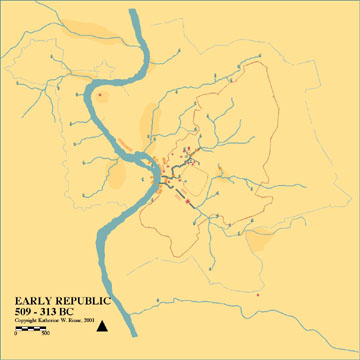Output Choices:
- Large JPEG
- X3D
(For X3D plug-in information click here.)
You have chosen to view:

Output Choices:
|
You have chosen to view: |
Click here to view Map Legend
The Early Republic was a time of tremendous growth in Rome, but there may not have been any significant innovations in water management. Rather it appears that there was a continual refinement of existing infrastructure. Port facilities were expanded as trade became more important. Large numbers of cisterns and wells became necessary as the population increased. Many of these wells were located along public roads and were probably designated for public use. The so-called "Servian Walls" were constructed bringing the Quirinal, Esquiline and Caelian hills into the city. Natural springs now located within the city walls, were contained by fountain structures. Important fountains, such as that at the Spring of Juturna, grew in importance as civic landmarks and became more elaborate.
To learn about any feature, open the map in JPEG, then click on the feature. This will link to an inventory entry with descriptive text, images, historic texts, archival maps and images, and to a bibliography. The complete inventory for most features is still under construction.